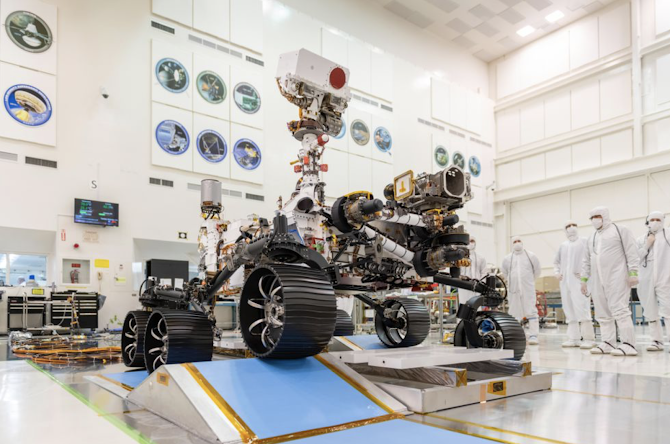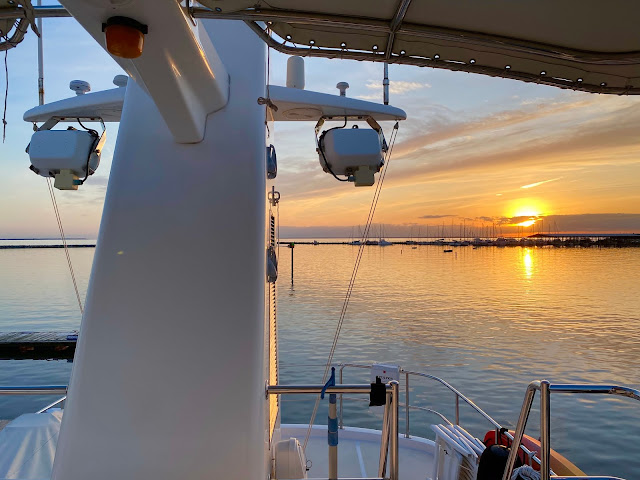Happy Perseverance Day!
February 15, 2021. Watching the launch from our flybridge. We were about 60 miles away.
It has been 10 years since NASA last flew to Mars. I was 3 years old. That was when the Curiosity rover reached the surface undamaged.
And Curiosity is still roving around today.
The images Perseverance will send us, packing 10 years of digital photography progress since Curiosity, should be stunning!
At first, I thought space exploration didn't have a lot in common with our boat travels. But the more I thought about it, the more I saw things they share.
Both begin with a dream and a willingness to push limits. This is followed by planning, and a lot of hard work. That is followed by the commitment to launch (or buy, in the case of our boat). And that is followed by lots of uncertainty and anxiety, the need to handle unforeseen obstacles and painful setbacks, the need to find or invent solutions, lots of learning along the way, new discoveries, wonderment, humility, and great feelings of accomplishment and gratitude.
Perseverance is a great adventure. Our boat travels are our great adventure. The ability to watch the former reach Mars, while underway in the latter, is pretty awesome.
__________
If you are reading this Thursday, February 18, 2021, and it's still morning, you're in luck! NASA's livestream of Perseverence's arrival at Mars begins today at 2:15 p.m. Eastern Standard Time (EST). At 3:55 p.m. EST, Perseverance will begin its 7 minute descent to the planet's surface. This, after launching on July 30th in the midst of a global pandemic, after traveling at an average velocity of 24,600 mph (that's 24,593 mph faster than our boat's cruising speed), and after covering 292.5 million miles over almost 7 months.
NASA calls the 7 minute descent "the 7 minutes of terror" because Perseverance cannot be guided or operated while it's happening. It's even more stressful because so many complex things have to happen perfectly during that time.
There are 15 steps to landing Perseverance. First, there is the cruise stage separation. When it enters the atmosphere, friction causes its heat shield to glow bright orange. This reentry experience slows the craft to just 1% of its remaining velocity. To slow that last 1%, a supersonic parachute will deploy. But even with the parachute open, Perseverance is still traveling 200 mph. So it sheds its heat shield, cuts loose its back shell, and a jet pack carrying the rover fires rockets which will gently lower Perseverance to the ground. Since that would stir up a lot of dust and debris, Perseverance is lowered its last few feet by a 21 ft rope. The rope then disconnects from the rover, and the jet pack flies away as far as its remaining fuel will take it before falling to the surface.
If all of that goes right, Perseverance is safe on Mars.
In the 7 minus descent, Perseverance is slowing from 13,000 mph to 0. Thanks to my Physics course, I was able to calculate the acceleration. If the slowing down was at a constant rate, the rate of acceleration (change in velocity divided by change in time) would be (13000 - 0 miles) / (0 - 420 seconds) = -30.95 miles per second squared. Talk about slamming on the brakes!
All this excitement and tension are huge for the 3,000 or so people who worked directly and indirectly on this mission, and it will be shared by millions of people around the world, until we all hear these 7 comforting words: “touchdown confirmed, we are safe on Mars.”
Mars 2020 launch. Safe travels, Perseverance. Photo source: NASA
Now here's something interesting. Though it takes 3.03 minutes for light to travel from Mars to Earth (at 186,000 miles per second), the satellites used to relay any signals from Perseverance delay the arrival of information by 12 minutes. So the event we are all waiting to hear about, will have happened, for better or worse, 12 minutes before. It doesn't take a rocket scientist to know what all of NASA will be thinking about at 4:02 p.m.!
__________
Perseverance is amazing! It is 7 feet tall, 10 feet long, 9 feet wide, and weighs 2,260 lbs on earth. (Since Mars has less gravity than we do, it weighs 62% less there.) It contains 19 cameras and 7 scientific instruments. The instruments will:
- Analyze the elements;
- Send radar signals downward, to find out what's underground (perhaps even ice or saltwater);
- Report on all types of weather conditions;
- Capture stereo images including zoom ones;
- Study mineralogy;
- Analyze chemical composition of rocks and soil and look for biosignatures (any past life); and
- Convert a small amount of the planet's CO2 atmosphere into O (Oxygen).
Perseverance is built to serve the instruments it carries. Even the extensively tested wheels. There are 6 of them and all 6 drive the rover. They are narrower, bigger in diameter, and thicker than the ones Curiosity had, and have twice as many "growsers" (treads). This makes them more resistant to wear from the rocky surface. They are made of machined aluminum with titanium spokes. The titanium spokes give the wheels some spring, sort of like making them into shock absorbers.
You might be thinking Perseverance is solar powered. But it isn't. The twin rovers Spirit and Opportunity were solar, but because Mars has dust storms, their panels were prone to collecting dust which seriously threatened their operation. (NASA got lucky with Spirit. A passing whirlwind blew off the dust.)
So what powers Perseverance? Something called a Multi-Mission Radioisotope Thermoelectric Generator (MMRTG), which is sort of like a nuclear battery. It converts heat from the radioactive decay of plutonium-238 into a steady flow of 110 watt electricity. The MMRTG also charges two lithium-ion batteries that can provide 900 watts when instruments working simultaneously call for more power. Since the rover will be working in temperatures around -80 F, it's also cool that the MMRTG provides heat to help the systems and instruments work better. And this source of power will continue, predictably, for 10+ years. I think this is amazing.
All this coolness is about to get even cooler.
If this were a TV infomercial, here's the part where they'd say: "But wait there's more! With Mars 2020, you get not one rover, but two!"
Perseverance brought a little friend to Mars. Say hello to Ingenuity.
Ingenuity is a 4 lb, 5.5 inch cube-shaped helicopter. Not a drone. A helicopter. If things go well, NASA says Ingenuity will be the first powered flight on another planet.
While Ingenuity is a helicopter, it had to be designed much differently from those we fly on Earth. The main reason for that is the atmosphere on Mars. It is only 1% of the volume of earth's. Ground level is like being 22 miles above sea level on Earth. A thinner atmosphere means a helicopter needs to be way more efficient to get off the ground. And so NASA engineered Ingenuity to be super light, to have bigger blades, and to spin those blades much faster (2,800 rpm). And while our Earth helicopters have two blades, one big horizontal one and one small vertical one (which stops the helicopter from spinning around), Ingenuity needed to have two large (4 ft in diameter) horizontal blades that counterrotate to stop the helicopter from spinning.
Since Mars has only 38% of our gravity, Ingenuity's blades don't have to push as hard against gravity.
So basically, Ingenuity is flying in conditions that on Earth would be equivalent to 100,000 ft. above sea level. (Our helicopter record height is only 13,000 ft.)
Because this is such a small helicopter, it has a maximum flight time of just 90 seconds, a maximum range of 2,000 ft., a maximum altitude of 1,300 ft., a horizontal velocity of 22 mph, and a vertical velocity of 6 mph.
__________
Though Mars is much smaller than Earth, with a circumference about 1/2 ours, it's still a planet with lots of landing sites. So why will it be landing in Jezero Crater? Jezero Crater is believed to have been an ancient lake. Perseverance will drill into the bottom of a delta that once spilled out of that lake to look for signs of ancient life.
Jezero Crater
If Perseverance finds evidence of past (or current) life, this will be by far the greatest discovery of all time. Our viewpoint of the Universe will be changed. We will know we are not alone.
And if Perseverance doesn't find life, there are many experiments it will do to help us better understand the red planet and our potential to live there someday. And our quest to find life will carry on.
__________
While this is all really amazing, why do it in the first place? I think it's the same reason why people climb the highest mountain or explore the bottom of the ocean. I think to explore is the human nature to know, to understand, and to accomplish the new and the extraordinary. And I think it's our nature to expand the tremendously confining boundary of what we know and don't know, and, sometimes, to take a leap into the unknown.
The number one objective of Perseverance is to "seek signs of past microbial life." This is our first rover mission with this objective. Wouldn't it be awesome to find out we're not alone?
Who would have known the name selected for this drone one year ago -- Perseverance -- would fit so well with what we as individuals, and as a county, must remind ourselves to never stop doing. Persevere.
I hope you enjoy this 2-1/2 minute NASA video about Perseverance. https://youtu.be/6qA9iaAUo8k
And I hope you enjoy the show at Jezero Crater!
Here's your link to the NASA live broadcast. https://youtu.be/gm0b_ijaYMQ
If you need more reasons to watch Perseverance touch down, this ought to do it. https://youtu.be/tH2tKigOPBU












I'll be sure to keep up to date. I was 15 when the astronauts landed on the moon. Think about how they had to design the spacecraft, communicate and get there without the aid of present technology. No internet, computers or satellite communication. Pretty amazing. Glad you had the opportunity to see it launch. Probably warmer on Mars than it is in Michigan.
ReplyDelete